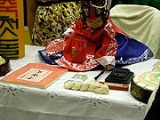
Doljanchi
Encyclopedia

Hanbok
Hanbok or Chosŏn-ot is the traditional Korean dress. It is often characterized by vibrant colors and simple lines without pockets. Although the term literally means "Korean clothing", hanbok today often refers specifically to hanbok of Joseon Dynasty and is worn as semi-formal or formal wear...
and a traditional hat: a jobawi
Jobawi
A jobawi is a type of traditional Korean winter cap with earflaps which was worn by women and was made of silk. Since its first appearance in the late Joseon period, it has been widely worn as a substitute for the ayam...
or gulle
Gulle
A gulle is a type of sseugae , Korean traditional headgear, worn by children aged one year to five years old during the late Joseon period. It was mostly worn by young girls in the upper class for warmth and style. Gullae was usually made with silk and in summer, it was made with sa , a type of...
for baby girls and a bokgeon
Bokgeon
Bokgeon is a type of gwanmo , traditional Korean headgear made from a black fabric. Although it had been worn by a few Confucian scholars until the late Joseon period, it later became a decorative headgear for baby boys' dol which is a way of celebrating the birthday of a one-year-old baby....
or hogeon
Hogeon
A hogeon is a type of gwanmo , Korean traditional headgear for young boys aged one year to five years old. It was worn along with durumagi or jeonbok . Hogeon was worn on holidays such as Seolnal , Chuseok , or celebrations for their birthdays like doljanchi...
(호건) for baby boys.
History
In the past, the death rates for children were high and many children died before their first birthday, so it was an important milestone to the baby and parents. The whole village used to celebrate a baby's first birthday, sharing foods and wishing for long life and fortune for the baby.Fortune telling ritual
The highlight of the dol is a ritual where the child is placed in front of a table of foods and objects such as string, books, brushes, ink and money. The child is then urged to pick up an object from the table. It is believed the one selected will foretell the child's future. For example, if the child picks up a brush or book, he is destined to be a scholar. If he picks up money or rice, he will be wealthy; cakes or other food, a government official; a sword or bow, a military commander. If the child picks up the thread, it is believed he will live a long life. The types of objects placed on the table for the baby to choose has evolved over time, as a reflection of society's evolving perception of successful occupations. Some parents place a computer mouse on the table, which signifies success in the high-tech field, or a toothbrush, hoping that the baby will be a dentist. However, many parents remain more traditional in their selection of objects to place on the table. This is followed by feasting, singing and playing with the toddler. Most often, guests will present gifts of money, clothes, or gold rings to the parents for the child at this time.'Dol' food

Miyeok guk
Miyeok guk is a Korean soup made from the sea vegetable miyeok. It comprises two words: miyeok, the Korean word for the sea vegetable; and guk, meaning "soup."...
(seaweed soup) is served on every birthday after the first birthday to remind people of what their mother went through to bring them into the world.

